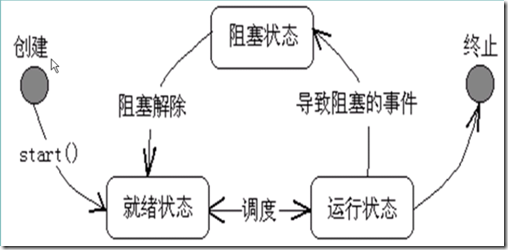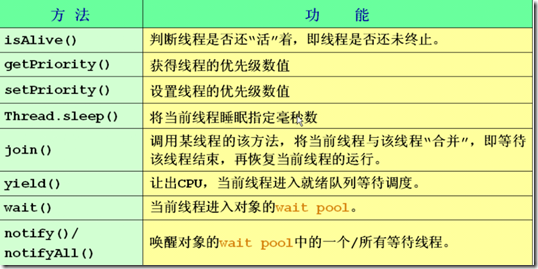一、线程简介
1、线程与进程
每个进程都具有独立的代码和数据空间,进程间的切换会有较大的开销。线程是轻量级的进程,同一类线程共享代码和数据空间,每个线程有独立的运行栈和程序计数器(PC),线程切换的开销小。
多进程:在操作系统中能同时运行多个任务(程序)
多线程:在同一应用程序中有多个顺序流同时执行
2、线程的应用
二、线程状态控制
线程具有创建、就绪、运行、阻塞、终止,五种状,详细的状态转换如下图所示:
1、线程的创建与启动
JVM启动时会有一个由主方法所定义的线程,程序员可以通过实现 Runable接口的类 或 Thread类 的实例创建新的线程,每个线程对象都是通过方法run()来完成其操作,通过start()方法来启动一个线程。
(1)定义线程类实现Runable接口【建议】
使用Runable接口可以更灵活的定义多线程,如:为多个线程提供共享的数据(线程同步问题),另外,在实现Runable接口的类的run方法定义中可以使用Thread的静态方法。
1 public class Main { 2 public static void main(String args[]) { 3 Runner1 r = new Runner1(); 4 Thread t = new Thread(r); 5 6 t.start();//r.run()是方法调用,而非线程启动 7 8 for(int i=0; i<100; i++) { 9 System.out.println("Main Thread:------" + i); 10 } 11 } 12 } 13 14 //同一个Runable可以创建多个Thread 15 class Runner1 implements Runnable { 16 public int a = 0; 17 public void run() {//定义线程体 18 for(int i=0; i<100; i++) { 19 System.out.println("Runner1 :" + i); 20 } 21 } 22 }
(2)定义Thread的子类,并重写run()方法
1 public class Main { 2 public static void main(String args[]) { 3 4 Runner1 r = new Runner1(); 5 r.start(); 6 7 for(int i=0; i<100; i++) { 8 System.out.println("Main Thread:------" + i); 9 } 10 } 11 } 12 13 //Thread类已经实现了Runable接口 14 class Runner1 extends Thread { 15 public void run() { 16 for(int i=0; i<100; i++) { 17 System.out.println("Runner1 :" + i); 18 } 19 } 20 } 21
(3)如何关闭一个线程
1 public class Main { 2 public static void main(String args[]){ 3 Runner r = new Runner(); 4 Thread t = new Thread(r); 5 t.start(); //线程启动 6 7 for(int i=0;i<10;i++){ 8 if(i%2==0 & i>0) 9 System.out.println("in thread main i=" + i); 10 } 11 System.out.println("Thread main is over"); 12 13 //stop()与interrupt()会立即关闭线程,造成正在打开的资源无法关闭,不建议使用 14 r.shutDown(); 15 } 16 } 17 //设置flag标志位,表示线程是否关闭 18 class Runner implements Runnable { 19 private boolean flag=true; 20 21 public void run() { 22 int i = 0; 23 while (flag==true) { 24 System.out.println(" " + i++); 25 } 26 } 27 28 public void shutDown() { 29 flag = false; 30 } 31 }
2、线程的基本操作
线程控制基本方法如下:
(1)线程优先级
JAVA提供一个线程调度器来监视程序中启动后进入就绪状态的所有线程。线程调度器按照线程的优先级决定调度那个线程来执行。线程的优先级用户数字表示,范围从1到10,线程的缺省优先级是5。
Thread.MIN_PRIORITY = 1
Thread.NORM_PRIORITY = 5
Thread.MAX_PRIORITY = 10
1 public class Main { 2 public static void main(String[] args) { 3 Thread t1 = new Thread(new T1()); 4 Thread t2 = new Thread(new T2()); 5 6 System.out.println(t1.getPriority()); //获取线程对象的优先级 7 t1.setPriority(Thread.NORM_PRIORITY + 3);//设置线程对象的优先级 8 t1.start(); 9 t2.start(); 10 } 11 } 12 13 class T1 implements Runnable { 14 public void run() { 15 for(int i=0; i<100; i++) { 16 System.out.println("T1: " + i); 17 } 18 } 19 } 20 21 class T2 implements Runnable { 22 public void run() { 23 for(int i=0; i<100; i++) { 24 System.out.println("------T2: " + i); 25 } 26 } 27 }
(2)线程wait与sleep方法
wait是Object的方法,调用wait方法时必须锁定对象,wait时别的线程可以访问锁定的对象,wait需要notify或notifyALL方法唤醒。
sleep是Thread静态方法,sleep时别的方法不能访问锁定的对象,sleep方法等睡眠时间到了,可以自己苏醒。
1 import java.util.*; 2 public class Main { 3 public static void main(String[] args) { 4 MyThread thread = new MyThread(); 5 thread.start();//每隔一秒输出一次时间 6 7 try { 8 //在未继承Thread类的方法在可以调用Thread的静态方法sleep暂停进程 9 Thread.sleep(10000); 10 } catch (InterruptedException e) { 11 e.printStackTrace(); 12 }//主线程等待10s 13 14 thread.interrupt();//不建议使用interrupt和stop 15 } 16 } 17 18 class MyThread extends Thread { 19 boolean flag = true; 20 public void run(){ 21 while(flag){ 22 //若调用该线程的主线程还“活着” 23 if(Thread.currentThread().isAlive()) { 24 System.out.println("==="+new Date()+"==="); 25 } 26 27 try { 28 //public static sleep(long millis)throw InterruptedException 29 //使得当前线程休眠,暂停执行millis毫秒 30 sleep(1000); //1000毫秒,即1s 31 } catch (InterruptedException e) { 32 //重写的方法不能抛出比被重写的方法不同的异常 33 //此处只能写try catch,不能写throws 34 return; 35 } 36 } 37 } 38 }
(3)线程合并
1 public class Main { 2 public static void main(String[] args) { 3 MyThread2 t1 = new MyThread2("myThread"); 4 t1.start(); 5 try { 6 t1.join(); 7 } catch (InterruptedException e) {} 8 9 for(int i=1;i<=3;i++){ 10 System.out.println("i am main thread"); 11 } 12 } 13 } 14 class MyThread2 extends Thread { 15 MyThread2(String s){ 16 super(s);//设置当前线程名为 s 17 } 18 19 public void run(){ 20 for(int i =1;i<=3;i++){ 21 System.out.println("i am "+getName());//输出线程名 22 } 23 } 24 }//线程合并结果,相当于方法调用
三、线程同步与死锁
1、线程同步
Java引入了对象互斥锁的概念,使用synchronized修饰符修饰方法和代码块,表明在某一时间段内,只能有一个线程访问被锁住的同步对象或同步方法,以保证共享数据的完整性;但其他线程仍可以访问没有锁定的方法,所以,要想保证数据同步,需将所有改变该属性值的方法都加锁,但锁加的越多,执行效率会被降低。建议对于读属性的方法无需加锁 。
1 public class Main implements Runnable { 2 3 private static int num = 100; 4 5 public static void main(String[] args) throws Exception { 6 Main test = new Main(); 7 Thread t1 = new Thread(test); 8 Thread t2 = new Thread(test); 9 //设置线程名字 10 t1.setName("t1"); 11 t2.setName("t2"); 12 //启动线程 13 t1.start(); 14 t2.start(); 15 16 // test.m2();//使t1和t2同步 17 // test.m3();//使t1、t2和主线程 同步 18 // System.out.println("Main"+" : "+(num)); 19 } 20 //在某一时间段,保证只有一个线程访问被锁住的方法 21 public synchronized void m1(){ 22 //若不使用死锁,num++和num输出 的原子性过程可能会打断,结果是都是102或101 23 num++; 24 System.out.println(Thread.currentThread().getName() +": "+ num); 25 } 26 27 //其他线程仍可以访问没有锁定的方法,导致数据有可能不同步 28 public void m2() { 29 num++; 30 } 31 32 //要想保证数据同步,需将所有改变该属性值的方法都加锁 33 public void m3() { 34 synchronized (this) {//互斥锁 35 num++; 36 } 37 } 38 39 public void run() { 40 try { 41 m1(); 42 } catch(Exception e) { 43 e.printStackTrace(); 44 } 45 } 46 }
2、线程死锁
(1)死锁实例
1 public class Main implements Runnable { 2 public int flag = 1; 3 static Object o1 = new Object(), o2 = new Object(); 4 5 public static void main(String[] args) { 6 Main td1 = new Main(); 7 Main td2 = new Main(); 8 td1.flag = 1; 9 td2.flag = 0; 10 Thread t1 = new Thread(td1); 11 Thread t2 = new Thread(td2); 12 t1.start(); 13 t2.start(); 14 } 15 16 public void run() { 17 System.out.println("flag=" + flag); 18 if(flag == 1) { 19 synchronized(o1) { 20 try { 21 Thread.sleep(500); 22 } catch (Exception e) { 23 e.printStackTrace(); 24 } 25 synchronized(o2) { 26 System.out.println("1"); 27 } 28 } 29 } 30 if(flag == 0) { 31 synchronized(o2) { 32 try { 33 Thread.sleep(500); 34 } catch (Exception e) { 35 e.printStackTrace(); 36 } 37 synchronized(o1) { 38 System.out.println("0"); 39 } 40 } 41 } 42 } 43 }
四、经典同步问题
1、生产者消费者
1 2 public class Main { 3 public static void main(String[] args) { 4 SyncStack ss = new SyncStack(); 5 6 //生成者 7 Producer p = new Producer(ss); 8 new Thread(p).start(); 9 10 //消费者 11 Consumer c = new Consumer(ss); 12 new Thread(c).start(); 13 } 14 } 15 16 class WoTou { 17 int id; 18 WoTou(int id) { 19 this.id = id; 20 } 21 public String toString() { 22 return "WoTou : " + id; 23 } 24 } 25 26 //支持多线程同步操作的堆栈的实现 27 class SyncStack { 28 private int index = 0; 29 private WoTou[] arrWT = new WoTou[6]; 30 31 public synchronized void push(WoTou wt) { 32 while(index == arrWT.length) { 33 try { 34 //Object的wait只能在synchronized修饰的方法中使用 35 //让当前正在访问的线程wait 36 this.wait(); 37 } catch (InterruptedException e) { 38 e.printStackTrace(); 39 } 40 } 41 this.notifyAll();//唤醒所有线程,此处也可使用notify()唤醒一个线程; 42 43 arrWT[index] = wt; 44 index ++; 45 } 46 47 public synchronized WoTou pop() { 48 //不能写if,在发生异常后还需在判断index值 49 while(index == 0) { 50 try { 51 this.wait(); 52 } catch (InterruptedException e) { 53 e.printStackTrace(); 54 } 55 } 56 this.notifyAll();// notify(); 57 index--; 58 return arrWT[index]; 59 } 60 } 61 62 class Producer implements Runnable { 63 SyncStack ss = null; 64 Producer(SyncStack ss) { 65 this.ss = ss; 66 } 67 68 public void run() { 69 for(int i=0; i<20; i++) { 70 WoTou wt = new WoTou(i); 71 ss.push(wt); 72 System.out.println("生产了:" + wt); 73 74 try { 75 Thread.sleep((int)(Math.random() * 200)); 76 } catch (InterruptedException e) { 77 e.printStackTrace(); 78 } 79 } 80 } 81 } 82 83 class Consumer implements Runnable { 84 SyncStack ss = null; 85 Consumer(SyncStack ss) { 86 this.ss = ss; 87 } 88 89 public void run() { 90 for(int i=0; i<20; i++) { 91 WoTou wt = ss.pop(); 92 System.out.println("消费了: " + wt); 93 try { 94 Thread.sleep((int)(Math.random() * 1000)); 95 } catch (InterruptedException e) { 96 e.printStackTrace(); 97 } 98 } 99 } 100 }

